Okay, you're pretty sure you've finally got your telescope aimed at the object of your desire. The crosshairs of your finderscope are on its exact location, according to the star charts you're using. Now what deep-sky objects do you hope to see?
[caption wid Persistence pays. Using a 7-inch reflector, Tony Flanders conquered the Messier catalog from this Cambridge, Massachusetts, park. Despite the floodlit shopping mall just behind him, Flanders was able to see more than one hundred star clusters, nebulae, and galaxies by exploiting good deep-sky observing techniques. Credits: S&T / Craig Michael Utter.[/caption]
Probably a lot less than you were expecting — but more than the disappointing first impression leads you to believe.
If your target is a bright star, it will be obvious and beautiful but contain no detail. Seen in a telescope, a star is a tiny blaze of brilliant light that looks pretty much as it does to the naked eye, only brighter. Much more interesting — but generally more difficult — are deep-sky objects: nebulae, star clusters, and galaxies. Hundreds of these ghostly glows and subtle spatterings are within reach of a modest telescope.
Let's say you've targeted Messier 87 (M87), an enormous elliptical galaxy in the springtime evening sky 55 million light-years away. At the eyepiece you'll see a small, shapeless, very dim gray smudge floating among a few pinpoint stars. While finding it should bring a thrill of accomplishment, many novices are let down by the sight. "Is that all there is ... to galaxies? It's nothing like the pictures in the books!"
You've just come up against the fact that the human eye does not work well in the dark. It cannot perform anywhere near as well as a camera does at very low light levels. We are daytime animals who evolved under a blazing sun; our eyes are not built for observing the distant night universe. Your eye's view of a galaxy will never match the spectacular photos in books and magazines. But here lies the challenge. Many deep-sky objects do show a surprising wealth of detail when studied long and well — even with the eyes that nature stuck you with for other purposes.
A telescope serves a different function on deep-sky objects than it does on the Moon, planets, or scenes on Earth. In those cases, its main purpose is to magnify distant detail. With deep-sky objects, on the other hand, a telescope's main function is to collect a lot of light for your less-than-sensitive eye. The main obstacle to seeing deep-sky objects is not that they're too small to see without optical aid. It's that they're too dim.
Accordingly, deep-sky observing involves its own techniques. All are aimed at helping the eye to see in near-total darkness. Here are some pointers every observer should know.
Persistence pays. Using a 7-inch reflector, Tony Flanders conquered the Messier catalog from this Cambridge, Massachusetts, park. Despite the floodlit shopping mall just behind him, Flanders was able to see more than one hundred star clusters, nebulae, and galaxies by exploiting good deep-sky observing techniques. Credits: S&T / Craig Michael Utter.[/caption]
Probably a lot less than you were expecting — but more than the disappointing first impression leads you to believe.
If your target is a bright star, it will be obvious and beautiful but contain no detail. Seen in a telescope, a star is a tiny blaze of brilliant light that looks pretty much as it does to the naked eye, only brighter. Much more interesting — but generally more difficult — are deep-sky objects: nebulae, star clusters, and galaxies. Hundreds of these ghostly glows and subtle spatterings are within reach of a modest telescope.
Let's say you've targeted Messier 87 (M87), an enormous elliptical galaxy in the springtime evening sky 55 million light-years away. At the eyepiece you'll see a small, shapeless, very dim gray smudge floating among a few pinpoint stars. While finding it should bring a thrill of accomplishment, many novices are let down by the sight. "Is that all there is ... to galaxies? It's nothing like the pictures in the books!"
You've just come up against the fact that the human eye does not work well in the dark. It cannot perform anywhere near as well as a camera does at very low light levels. We are daytime animals who evolved under a blazing sun; our eyes are not built for observing the distant night universe. Your eye's view of a galaxy will never match the spectacular photos in books and magazines. But here lies the challenge. Many deep-sky objects do show a surprising wealth of detail when studied long and well — even with the eyes that nature stuck you with for other purposes.
A telescope serves a different function on deep-sky objects than it does on the Moon, planets, or scenes on Earth. In those cases, its main purpose is to magnify distant detail. With deep-sky objects, on the other hand, a telescope's main function is to collect a lot of light for your less-than-sensitive eye. The main obstacle to seeing deep-sky objects is not that they're too small to see without optical aid. It's that they're too dim.
Accordingly, deep-sky observing involves its own techniques. All are aimed at helping the eye to see in near-total darkness. Here are some pointers every observer should know.
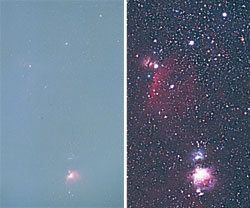
You can observe M42, the Orion Nebula, through severe light pollution (left), but far more of it will be visible in a dark, moonless sky (right). M42 is the glowing patch near the bottom of these photos, which include Orion's Belt (near the top of each frame) and Sword.
S&T / Dennis di Cicco
Sky Brightness
The single most important factor in observing deep-sky objects is light pollution. Its worst effect is on dim, extended objects of just the sort we're considering. A dark sky matters even more than telescope size; a small instrument in the country will show faint nebulae and galaxies better than a large telescope in a city.
That being said, even if you live in a badly light-polluted area you can take pleasure in what can be seen through the skyglow. New York City observer Jenny Worsnopp has examined nearly the entire Messier catalog from her Manhattan rooftop. Cambridge, Massachusetts, amateur Tony Flanders did the same from a city park. Just remember not to blame yourself or your telescope for what may seem like mediocre results. Rather, make a note to bring your telescope along on country getaways.
The higher in the sky you look, the darker the sky will be. Plan your deep-sky observing projects accordingly. Also, light pollution tends to improve a bit after 11 or midnight as some outdoor lights get turned off.
Keep an eye on the daytime sky. The deeper and cleaner the blue is in the afternoon, the cleaner and darker the air will be at night.
Moonlight, of course, is nature's own light pollution. When moonlight is in the sky, plan on sticking to bright targets.
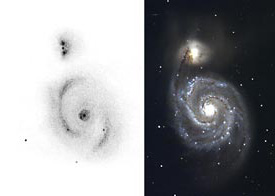
The Whirlpool Galaxy (M51) in Canes Venatici, as sketched by skilled observer Roger N. Clark using an 8-inch Cassegrain telescope under a perfect, pitch-black sky, and as imaged by a CCD-equipped 0.9-meter (36-inch) telescope on Arizona's Kitt Peak. The Whirlpool was the first 'spiral nebula' to be perceived as such by eye.
Drawing: Roger Clark / photo: NOAO
Dark Adaptation
The human eye takes time to adjust to the dark. Your eyes' pupils expand to nearly their full nighttime size within seconds whenever you step out into the dark. But the most important part of dark adaptation involves chemical changes in the retina, and these require many minutes.
After spending 15 minutes in darkness you might think your night vision is fully developed. But in fact your eyes gain as much as another two magnitudes of sensitivity — a factor of six — during the next 15 minutes. Thereafter, dark adaptation improves very slightly for 90 minutes more. So don't expect to see faint objects at their best until a half hour or more into an observing session.
In practice, complete darkness is unattainable. Light pollution aside, you need some light to see what you're doing. Astronomers have long used dim red flashlights because red light harms night vision least. In near-darkness you see with your retina's rod cells, and these are nearly blind to the far red end of the visible spectrum. When you see red light your cone cells are at work; they are responsible for normal daytime color vision. (You have three types of cones — red, green, and blue — but only one type of rod, which is fairly insensitive to red.) You want to use your red cones for reading charts and working with hardware, while protecting your rods for delicate work at the eyepiece.
You can get a dim, diffuse glow by rubber-banding red paper over the front of a flashlight. You also can dim and somewhat redden a two-battery flashlight by installing a bulb rated for three or four batteries. Much better than these traditional approaches, however, is a red LED (light-emitting diode) flashlight. Its purer, deeper red light more sharply discriminates between rod and cone vision. LEDs also use very little current, so batteries last for years. Many LED flashlights are available for astronomers.
Another trick for preserving dark adaptation is to observe with one eye and read charts with the other. Keep the observing eye closed or covered with an eye patch when not in use.
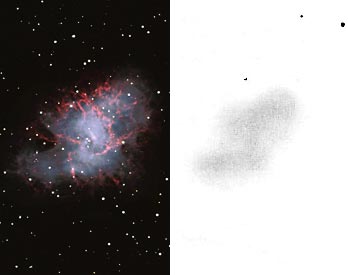
The Crab Nebula (M1) in Taurus, as photographed by the Kitt Peak 4-meter reflector (left) and sketched as seen through an 8-inch Cassegrain telescope under a superb dark sky (right).
Photo NOAO / drawing: Roger N. Clark
Averted Vision
When you look directly at something, its image falls on your retina's fovea centralis. This spot is packed with bright-light-optimized cone cells and provides sharp resolution under strong illumination. But the fovea is fairly blind in dim light. So to see something faint, you have to look slightly away from it. Doing so moves the image of your target off the fovea and onto parts of the retina that have more rod cells, which see only in black and white but are more light-sensitive than the cones.
To see this effect at work, stare straight at a moderately faint star. It will disappear. Avert your gaze just a bit; there it is again.
Practice concentrating your attention on things a little off to one side of where your eye is aimed. This technique is called averted vision. You'll be using it almost all the time when deep-sky observing.
As it turns out, your eye is most sensitive to a faint object when that object lies 8° to 16° from the center of vision in the direction of your nose. Almost as good a position is 6° to 12° above your center of view. Avoid placing the object very far on the "ear side" of your center of vision; it may fall on the retina's blind spot there and vanish altogether.
In practice, finding how far to avert your vision is a matter of trial and error. Not enough and you don't get the full benefit; too much and you lose the ability to resolve details.
Your peripheral vision is highly sensitive to motion. Under certain conditions, wiggling the telescope makes a big, dim ghost of a galaxy or nebula almost pop into view. When the wiggling stops, the object disappears again into the vague uncertainty of the sky background.
But under other conditions, just the opposite technique may work, especially with objects that are both faint and tiny. According to Colorado astronomer Roger N. Clark's 1990 book Visual Astronomy of the Deep Sky, some studies indicate that the eye can actually build up an image over time almost like photographic film — if the image is held perfectly still. In bright light the eye's integration time, or "exposure time," is only about 1/10 second. But in the dark, claims Clark, it's a different story. A faint image may build up toward visibility for as long as 6 seconds if you can keep it at the same spot on your retina for that long. Doing so is quite contrary to instinct, because in bright light fixating on something tends to make it less visible with time.
Long exposure times might possibly be one reason why an experienced observer sees deep-sky objects that a beginner misses. Perhaps the veteran has learned, unconsciously, when to keep the eye still. It also may help to explain why bodily comfort is so essential for seeing faint objects. Fatigue and muscle strain increase eye motion.
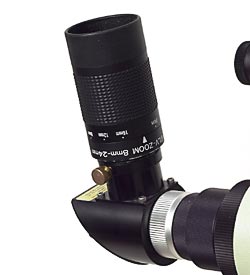
A modern, high-quality zoom eyepiece, like this 8-mm to 24-mm model from Orion Telescopes & Binoculars, can help you pan in and out to find the optimal magnification for viewing a particular star cluster, galaxy, or nebula.
S&T / Craig Michael Utter
Using High Powers
Conventional wisdom holds that low magnification (low power) works best for deep-sky viewing. After all, low power concentrates an extended object's light into a small area, increasing its apparent surface brightness (the amount of light hitting a given square millimeter of your retina). But, as Roger Clark has documented, this assumption is usually false. High powers should do better on many faint deep-sky objects. The reason is subtle but important, so we'll go into some detail.
Unlike a camera or other purely mechanical lens system, the eye loses resolution in dim light. This is why you can't read a newspaper at night, even though you can see the newspaper, and even though your large nighttime pupil should theoretically resolve the letters even more sharply than in daylight. Studies show that the eye can resolve detail almost as fine as 1 arcminute (1/60 of a degree) in bright light but can't make out features smaller than about 20 or 30 arcminutes (1/3° to 1/2°) wide when the illumination is about as dim as the unpolluted night sky. This is almost the size of the Moon as seen with the naked eye. So, details in a very faint object can be resolved only if they are magnified until they appear tens of arcminutes across. In many cases, this can require using extremely high power!
Why does the eye work this way? The explanation lies in how the visual system has adapted to cope with night. Photographic film records light passively, but the retinal nerve system contains active computing power. In dim light, the retina compares signals from adjacent areas. A faint source covering only a small area — such as a small galaxy in the eyepiece — may be completely invisible at the conscious level. But it is being recorded in the retina, as evidenced by the fact that a larger galaxy with the same low surface brightness is visible easily. In effect, when rod cells see a doubtful trace of light they ask other rods nearby if they're seeing it too. If the answer is yes, the signal is passed on up the optic nerve to the brain. If it's no, the signal is disregarded.
When an image is magnified by high power, its surface brightness does indeed grow weaker. But the total number of photons of light entering the eye remains the same. (A photon is the fundamental particle of light. Experiments show that most people can detect as few as 50 to 150 photons per second.) It doesn't really matter that these photons are spread over a wider area; the retinal image-processing system will cope with them. At least within certain limits. A trade-off is needed to reach the optimum power for low-light perception: enough angular size but not too drastic a reduction in surface brightness.
What does all this mean for deep-sky observers? Simply that it's wise to try a wide range of powers on any object. (A judiciously chosen, high-quality zoom eyepiece makes this a breeze.) You may be surprised by how much more you'll see at one power than another.
One more point: There is a folk belief among observers that a telescope of long focal length (high f/ratio) gives a cleaner, higher-contrast view of dim objects than a short focal-length scope. But f/ratio is not the issue. A long-focus telescope is simply more likely to be used at high power! (It's also more likely to have high-quality optics, because "slow" mirrors and lenses are easier to manufacture well than "fast" ones.)
Capturing Color

Left: We're accustomed to beautiful color images of the Orion Nebula (M42). But most deep-sky objects manifest themselves in shades of gray at the eyepiece (right).
Deep-sky objects disappoint beginners not only by lacking obvious detail, but also by lacking the brilliant colors recorded in photographs.
In order to show us color, a deep-sky object must have a high enough surface brightness to stimulate the retina's cone cells — and the list of deep-sky objects this bright is short. The brightest parts of Great Orion Nebula (M42) qualify, as do some small but high-surface-brightness planetary nebulae. The ability to see color in dim objects varies greatly from person to person, and surprises may occur.
Averted vision is not the way to look for color. The cones are thickest in the fovea, so stare right at your object. In this case, the lowest useful power should work best. A large telescope aperture is especially advantageous for those who seek to see color in deep-sky objects.
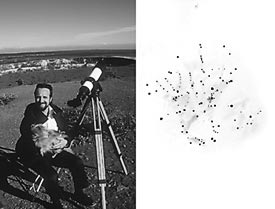
Persistence pays. Using a premium 101-mm (4-inch) telescope, Stephen James O'Meara has seen hundreds of deep-sky objects from the Big Island of Hawaii (left). His sketch of the North America Nebula, NGC 7000, (right) reflects good technique as well as a pristine site.
Photo © 2001 Donna Donovan O'Meara
Other Tips on Observing Deep-Sky objects
Every deep-sky observer, even those with computer-pointed telescopes, will appreciate highly detailed star charts such as those in Uranometria 2000.0 or the Millennium Star Atlas. If you know exactly where a faint deep-sky object is supposed to be located in your telescopic field of view, you will be able to detect objects about a magnitude fainter than you could otherwise see with certainty. That's about like increasing your telescope's aperture by 60 percent. A 10-inch becomes a 16-inch.
Alternatively, a portable computer at the telescope can display the very detailed and flexible star-charting software available from many sources. Red cellophane over the screen will save your night vision.
When you pour all your concentration into examining a deep-sky object at the very limit of vision, does it get even harder to see after 10 or 15 seconds? Does the sky background brighten into a murky gray? Diagnosis: you're holding your breath without realizing it. Low oxygen kills night vision fast. An old variable-star observer's trick is to breathe heavily for 15 seconds or so before trying for the very dimmest targets. And keep breathing steadily while you're looking.
Night vision also is impaired by alcohol, nicotine, and low blood sugar, so don't drink, smoke, or go hungry while deep-sky observing. Bring a snack. A shortage of vitamin A impairs night vision, but if you've already got enough of it, taking more won't do any good. Few people in the developed world manage to get vitamin-A deficiency, unless they have a crappy diet of junk food, so don't expect a quart of carrot juice to improve your eyesight. But do eat your vegetables.
Prolonged exposure to bright sunlight reduces your ability to dark-adapt for a couple of days, so wear dark glasses when spending much time outdoors. Make sure the label on the dark glasses says they block ultraviolet light (both UVA and UVB); some cheap ones don't.
Over the years ultraviolet daylight (and maybe even bright visible daylight) ages both your eye lens and retina, reducing sensitivity and increasing the likelihood of degenerative diseases such as cataracts and macular degeneration. So if you wear ordinary eyeglasses outdoors, ask your optometrist to have an ultraviolet-filter coating applied to them. This option is so cheap and easy, and will reduce your lifetime UV exposure so greatly, that every eyeglass wearer ought to get it regardless of any immediate medical need.
Polycarbonate eyeglass lenses block ultraviolet light by themselves with no coating required, which lets you have antireflection coating applied to them instead — highly recommended for any night-sky observer.
Most of all, be patient. If at first you don't see anything where a star cluster, nebula, or galaxy is supposed to be, keep looking. Then look some more. You'll be surprised at how much more of the scene glimmers into view with prolonged scrutiny — another faint little star here and there, and just possibly the object of your desire. After you glimpse your quarry once or twice, you'll glimpse it more and more often. After a few minutes you may be able to see it almost continuously where at first you thought there was nothing but blank sky.
You can be confident that your observing skills will improve with practice. Pushing your vision to its limit is a talent that can only be learned with time. "You must not expect to see at sight," wrote the 18th-century observer William Herschel, often considered the founder of modern astronomy. "Seeing is in some respects an art which must be learned. Many a night have I been practicing to see, and it would be strange if one did not acquire a certain dexterity by such constant practice."
 0
0








Comments
You must be logged in to post a comment.